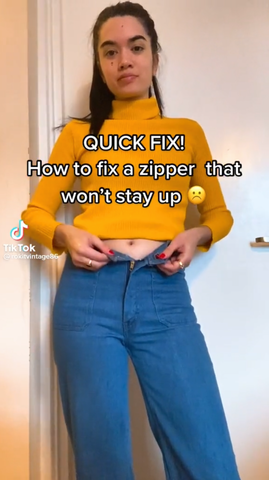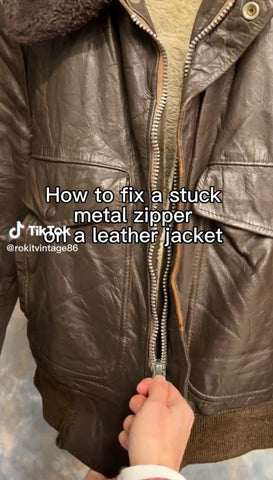5 Easy DIY Hacks to Repair Vintage Clothing
Every vintage item offers something truly unique. May that be in its quality, its timeless style or its place in fashion history. These one of a kind items should be treasured and cared for, just like antique heirlooms.
Vintage clothing is our thing - it has been since ‘86. So we’d say we know something about how to make vintage clothes last longer. In this post, we’ll give you some clothing preservation tips that will make DIY clothing care as easy and a part of your everyday life as tying your shoelaces.
Here are 5 Easy ways to repair vintage clothing:
1. Stop zippers falling down
Ever had a case of the falling trouser zipper?
Over time, zip slides on vintage clothing can begin to stretch and warp. This can happen a lot on vintage denim due to the fabric density. But don’t worry, there’s an easy fix to stop zippers falling down on trousers without having to send it to a tailor.
Find a spare key ring loop that is big enough to fit around your trouser button. Attach it to the end of the zip slider. And voila!
2. Remove bobbles from clothes
Most knitted clothing (vintage knitwear especially) will go through a bobble stage of their life, also known as piling. This is a result of average wear and tear as the knitted fibres break down and twist up at the surface.
One quick way to get rid of bobbles from clothes is by using a razor. Just simply make your garment taut and gently shave off the bobbles. Easy!
3. Creative Mending Moth holes
For those of us with no technical know-how in mending, creativity is your friend when it comes to repairing moth-bitten clothes.
Rather than learning how to fix moth holes, why not create a completely personalised item of clothing by decorating the holes?
Take any needle and any thread. Double or triple up your thread so it becomes thicker and more like embroidery floss. Wrap the thread around the hole to decorate and reinforce the moth holes.
4. Unstick a Zipper
A stubborn zip shouldn’t be the reason you get rid of a jacket. But how do you fix a stuck zipper?
Firstly investigate the zip as there could be a few reasons why your zip is stuck. Check if the fabric isn’t catching. If it is, gently tug at it.
For vintage clothing, especially for vintage leather jackets, metal zips need a little bit more help. To get them running smoothly, you need to lubricate the metal. Grab a sharpened pencil and begin to rub it against the teeth of the zip. The graphite of the pencil will create a natural lubricant to get the zip doing its job again!
5. Cover a Stain
Stains happen to the best of us and sometimes, whatever we try, we just can’t get rid of the stain. Either it’s a stubborn one or it’s a hand-wash-only vintage item. So, how to cover a stain on your clothes?
Patch it up! Find a patch big enough to cover a stain like one of our a vintage military patch or maybe you can make your own.
Patches can be applied in two different ways. Simply sew it on or add a sticky fusing material and iron it on to cover the stain.
Other options to cover stains include using a vintage broach. Or if you're really time poor, just stick a sticker on them - we promise, no one will notice...
Embrace the wear & tear of loved clothes
No matter how good quality your clothing is when you bought it, wear and tear is inevitable. This is the beauty of vintage clothing to us. Small stains, a well used zipper, and moth holes shows that the item has been well loved over a significant period of time.
By incorporating these 5 DIY clothing repair hacks into your life, not only will your vintage clothes last longer they will also be decorated in a way that is unique to you! A win-win we'd say :)





